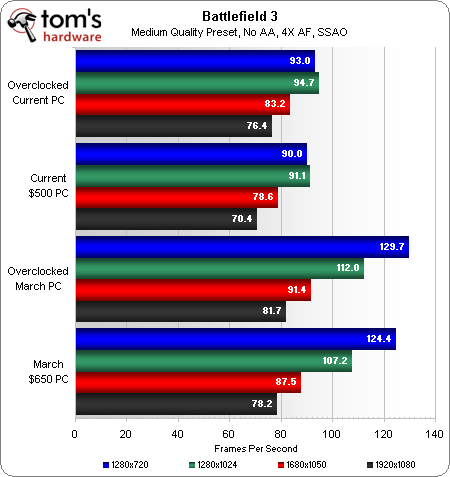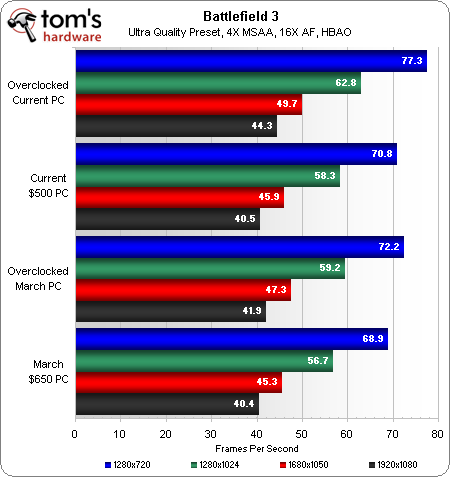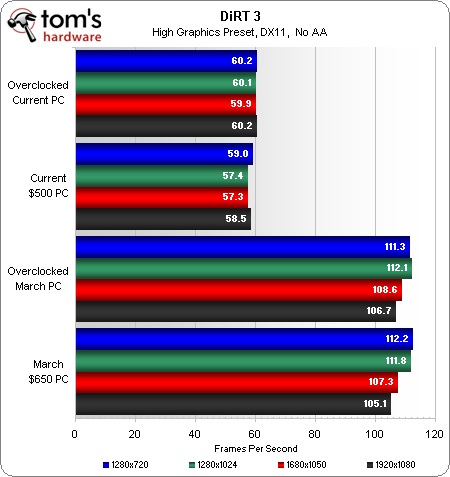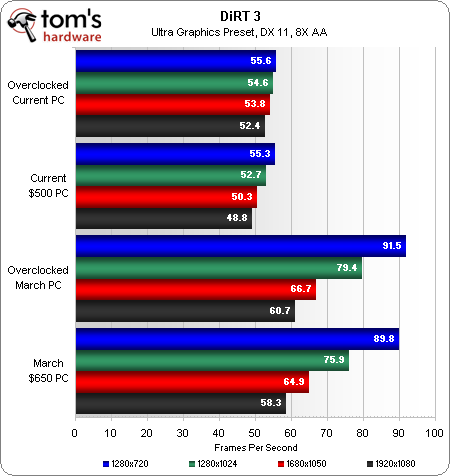System Builder Marathon, June 2012: $500 Gaming PC
Benchmark Results: Battlefield 3 And DiRT 3
Battlefield 3
Having explored the synthetic capabilities of our current system, we’re going to jump right in and take on Battlefield 3’s single-player campaign, the most graphically demanding test in our current gaming suite. There are more stressing areas encountered within the game than our 90-second Fraps test, so I shoot for an average of 45 frames per second as a minimum target.
Our $500 PC shows evidence of a CPU limitation at lower resolutions, though it still benefits slightly from reduced memory timings and graphics overclocking. But both builds are plenty capable at the Medium quality preset.
Since the rig was designed specifically to tackle Battlefields 3’s Ultra quality preset, we put in a bit of extra effort into optimizing for these settings. Passing final judgment on our budget gaming builds required extra play time on both configurations.
The current $500 system has a slight lead at all resolutions, especially if we focus on the test set including graphics overclocking.
Although the 2-3 FPS lead in both average and minimum frame rates might seem insignificant, playing through a couple of missions made it clear to us that today's $500 PC offers a better experience at 1920x1080 than last quarter's $650 PC. In fact, in my opinion, this new build feels smoother than December's Core i5-2400/Radeon HD 6870 combination at 1680x1050.
To be fair, though, performance at 1920x1080 must be called marginal. There were a few brief dips below 30 FPS and periods of sustained performance in the mid-30 FPS range. I could live with that in the single-player campaign, though not happily. Unsure of whether the entry-level processor or mid-range graphics card was to blame, I spent more time playing at 1280x720. Dropping the resolution while maintaining the same aspect ratio helps determine which component is the limiting factor. Frame rates rarely dipped below 40 FPS and sustained performance jumped to the mid-40s. Surprisingly, our little Celeron G530 was not the culprit; we needed more graphics horsepower.
We conclude, then, that Nvidia has a slight advantage in Battlefield 3 (at least in the single-player campaign). But more aggressive overclocking could have made a difference for the Radeon HD 6950- and GeForce GTX 560 Ti-powered systems.
DiRT 3
Minimal scaling is seen on both systems using DiRT 3's High graphics preset, as the comparably beefy video cards are held back by their complementary dual-core CPUs. This huge frame rate deficit will handicap the current system when it come the overall gaming evaluation, but the rig still offers playable performance, delivering minimum frame rates in the low 40s at all resolutions.
Ultra detail settings with 8x AA shifts our bottleneck over to the $650 PC's graphics card. But this quarter's machine's CPU continues to limit performance (at least at the lower resolutions). At our 1920x1080 target, the stock $500 build maintains at least 39 FPS at all times. That minimum jumped an additional 2 FPS through overclocking.
Current page: Benchmark Results: Battlefield 3 And DiRT 3
Prev Page Benchmark Results: Synthetics Next Page Benchmark Results: The Elders Scroll V: Skyrim And StarCraft IIGet Tom's Hardware's best news and in-depth reviews, straight to your inbox.
-
mayankleoboy1 why are you not increasing the voltages on the GPU to get more clocks ?Reply
any enthusiast with limited budget would want to maximize his core clocks with higher voltages.. the card can keep cool by increasing the fan speed.
More noise for a gaming session is acceptable. -
mayankleoboy1 ReplyDumping the bulk of our funding into graphics is sure to spell disaster throughout the media encoding and productivity benchmarks. But it's time to face the music.
pun intended ? ;) -
s3anister Celeron G530 is what I'm rocking in my gaming rig. It is definitely a capable processor, surprising given the legacy behind anything labeled Celeron.Reply -
s3anister Slomo4shOWould have liked to see Diablo 3 and SC 2 benchmarks for this build.I can't give you exact fps rates, but my machine is very similar to this one (only difference is the GPU: 6950+Z68) and I get similar frame rates in all the tested games. So I'll infer to you what this rig would probably get close to.Reply
Diablo 3 maxes out at 60fps with occasional dips down to ~30fps when getting mobbed on hell. As for SC2, frame rates for me tended to be around 35fps on average with everything maxed out at 1920x1080 for both games. -
pauldh s3anisterCeleron G530 is what I'm rocking in my gaming rig. It is definitely a capable processor, surprising given the legacy behind anything labeled Celeron.Ah, but think way back.... slot 1, 440BX, and the Celeron 300A? I had a 266@412MHz, a 300A@464MHz, a 300A@450MHz, and a 333(that topped out down at an 83 MHz FSB).Reply
While not the first chips I had overclocked, those slot 1 Celeron's gave me the incurable OC bug! *dreams of G530K* -
jestersage Amazing! I never thought an SBM machine would ever come this close to my own rig. And confirm for me that my drooling over $200+ graphics cards is not an impractical fantasy for my current rig. I've been dreaming of retiring my old GT240 for a newer card and had the HD7850 (or comparable Nvidia counterpart when it comes out) in mind, or even an HD7770. I now feel justified and my wife will go nuts over the pc part purchase, again.Reply
I did notice one thing when I compared this build with my system - mine idles at 48-52 watts, too, and I use a 500W S12II. I think right-sizing the PSU will add to the efficiency. A 350w PSU is my bet for bringing the idle power draw closer to the 20% mark of the PSU rating where efficiency starts to pick up (as per 80plus requirements). I say 350w because whoever gets this will likely want to upgrade the CPU to something beefier sooner or later. Nah, sooner!
Thanks, Paul! for tackling love and system-building with reckless abandon. -
bustapr i got a question. if I were to use a phenom 2x4 965 BE(3.4ghz) for a gaming rig on a similar budget to this, would it bottleneck me in gaming and other applications?Reply -
pauldh mayankleoboy1why are you not increasing the voltages on the GPU to get more clocks ?any enthusiast with limited budget would want to maximize his core clocks with higher voltages.. the card can keep cool by increasing the fan speed.More noise for a gaming session is acceptable.As mentioned, it was maiinly a matter of consistency with the past few builds. Dealing with fixed CPU clocks and memory frequency, I just haven't been too aggresive with previous efforts with Radeons, and thus didn't want to boost voltage here with the GTX. Trying to play it fair, that's all. Maybe once we revisit overclockable platforms, and are already dealing with increaded noise, I'll get itchy to max-out the GPU.Reply
Thanks for the feedback though. I'm actually surprised given the balance of the system, that people would desire to see aggressive GPU overclocking.




